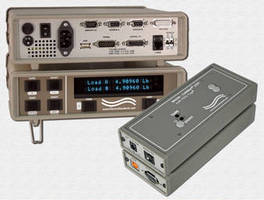TEDS Tag System stores multiple load cell calibrations.
Press Release Summary:

TEDS-Tag Auto-ID System retains self-identification feature of TEDS (Transducer Electronic Datasheets) standard and can be implemented on any load cell. TEDS-Tag auto-ID feature with integrated electronic tags lets Model 4215 Strain Gauge Indicators and CellMite Intelligent Digital Signal Conditioners automatically select correct sensor calibration and analog output for scaling for connected transducer. Multi-load-cell and multi-instrument matched pair calibrations are also supported.
Original Press Release:
ESL Instruments Implement TEDS-Tag to Easily Store Multiple Load Cell Calibration Entries
Electro Standards Laboratories, Cranston, RI, manufactures state-of-the-art CellMite Intelligent Digital Signal Conditioners as well as the Model 4215 Strain Gauge Indicators. These units operate in conjunction with TEDS-Tag load cell systems to match each load cell with its calibration data. TEDS refers to Transducer Electronic Datasheets. TEDS technology can store data inside of a memory chip that can be installed inside of a TEDS-compliant load cell. The TEDS standard specifies a huge number of detailed electronic data templates.
The ESL TEDS-Tag Auto-ID System retains the self-identification feature of the TEDS standard and is simple to implement on any load cell. The TEDS-Tag auto-ID feature with integrated electronic tags allows the Model 4215 and the CellMite to automatically select the correct sensor calibration and analog output for scaling for the connected transducer. Multi-load-cell and multi-instrument matched pair calibrations are also supported, a critical advantage in field calibration services.
With the TEDS-Tag system, a small, inexpensive electronic identification chip is placed in the cable extending from the load cell or it can be mounted within the load cell housing. This chip contains the unique electronic serial number that can be read by the ESL Model 4215 or CellMite to identify the load cell. The load cell is then connected to the Model 4215 or the CellMite and a standard calibration procedure is performed. The instrument automatically stores the calibration data inside the unit itself along with the unique load cell identification number from the microchip. Whenever that load cell is reconnected to the instrument, it automatically recognizes the load cell and self-installs the appropriate calibration data. True plug-and-play operation is achieved.
With the ESL TEDS-Tag Auto-ID System, the calibration data can automatically include compensation for the particular instrument so that high-precision matched systems are realized. If the load cell is moved to another instrument, that instrument recalls the calibration data that it has stored internally for that load cell. The ESL instruments can store multiple load cell calibration entries. In this way, multiple load cells can form a matched calibration set with multiple instruments.
In the Downloads section of ESL’s Website, an application note is available on making a TEDS-Tag plug-and-play load cell with an inexpensive chip that fits into a cable hood or into the load cell housing. There are also instructions on how to make an in-line TEDS-Tag ID System. The in-line system is ideal for applications requiring different calibrations on the same load cell. With a single load cell and instrument, the user changes the calibration to be auto-selected by simply changing the in-line cable adapter. Since each cable adapter has a different tag identification chip, the ESL Model 4215 or the CellMite associates a different calibration data set with each in-line adapter. One example of an application for this technique is the requirement of a precision 6-point linearization of the load cell in two different operating ranges of the same load cell.
The TEDS-Tag converted load cell can be connected to the ESL Model 4215 or the CellMite. The first time it is connected, a standard calibration procedure is performed to initialize the cell’s calibration data in the instrument. The ESL instruments support a variety of industry standard calibrations including mV/V, precision shunt, 2-point or multi-point calibration. The instrument then automatically detects the presence of the TEDS-Tag load cell and matches it with its calibration data. From this point forward, the system is completely plug-and-play. After the load cells have been initially calibrated on the instrument, changing cells is done by simply plugging the new cell into the instrument and turning the power on.
The ESL Model 4215 is a calibration-quality unit that has internal nonvolatile storage for the calibration data of 25 load cells. This unit with auto load cell identification is ideal for field calibration service. For embedded applications or for applications that require direct digital communications with a PC, the ESL CellMite can be used.
The CellMite has internal nonvolatile storage for the calibration data of 3 load cells. The CellMite outputs analog voltages as well as direct-to-PC digital readings. The CellMite can be used with GUI software or standalone to replace an analog load cell signal conditioner. When it identifies a TEDS-Tag load cell, it not only auto-installs the corresponding calibration data needed to take measurements from the cell, it also auto-installs gain and offset factors for its 16-bit scalable analog output. The voltage range and offset of the analog output is automatically changed to match the corresponding load cell. Using the CellMite in this way is like having multiple analog load cell signal conditioners all in one, and having them automatically removed, installed, and matched with a load cell, all without any user intervention.
For more information on Plug-and-Play Load Cell Calibration Systems, contact ESL at www.electrostandards.com or eslab@electrostandards.com. To speak to a knowledgeable sales engineer regarding ESL load cell instrumentation, call 401-943-1164.




